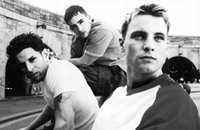In today's world of prefabricated, media-driven, and often disposable pop culture, it is surprising and reassuring to witness the evolution of great and promising young talent right before one's eyes. Such is the story of LFO.. LFO first made their mark as the three guys who brought us the 1999 chart topping smash "Summer Girls." The song, penned by the group's founder Rich Cronin, blended his equally strong passion for both hip-hop and pop music while waxing rhapsodic about young love and "girls that wear Abercrombie & Fitch.".
Though the group's No. 1-selling summer anthem powered LFO to sell two million albums, four million singles, and perform over two hundred concerts in the year 2000, many in the media wondered if there was a real future for LFO or if they were just another page in the "listen once and then dispose" pop music business. Well, with their sophomore album, LIFE IS GOOD, LFO is leaving no doubt that this group is a whole lot deeper than a glass of water...
The three LFO groupmates, Rich Cronin, Brad Fischetti, and Devin Lima, who worshiped hip-hop and R&B while growing up in Boston and New Jersey, followed their dream of becoming recording stars to Orlando, where they met pop impresario Lou Pearlman, the mastermind of prefab groups N’Sync and Backstreet Boys. That LFO came together organically instead of through an audition process resulted in a strong bond between them, a bond that helped them through Pearlman's frustrating attempts to fabricate them into a typical "boy band." At the same time, "Summer Girls" started getting discovered by radio DJs in Washington, D.C. and New York and quickly .became a smash. .
To capitalize on the instant success of "Summer Girls," the guys had only one month to complete their debut album, but that didn't stop the record from spawning another top 10 hit, "Girl on TV," also written by Cronin. As they became more successful, LFO grew more unhappy with the level and quality of attention they received from their management company, and they've since split with Pearlman, joining ranks instead with industry veterans Bruce Garfield, Jerry Goldstein, and Glenn Stone who have worked with artists as diverse as Led Zeppelin, Isaac Hayes, Sly Stone, WAR and Duran Duran.
Their new found freedom allowed LFO to spread their creative wings, mining new musical influences, ranging from pop, soul, and hip-hop to psychedelic '60s rock, for their second record. With LIFE IS GOOD, the bandmates have undergone what Teen People magazine calls "one of the most dramatic growth spurts in recent pop history." . The record has a straight-ahead, smile-inducing, R&B-tinged pop sound that features layers of vocals, guitars, even organs and horns, all the while maintaining a distinctive LFO vibe. The new, more diverse sound is best represented by "Every Other Time," Life is Good’s first single. "The hits from the first record were very simple, pretty much just acoustic guitars, some keyboards, and drums. And that was the magic to those songs," Rich says. "But if you can have a good song and incorporate a lot of layers of ear candy, that's even better."
All the more impressive, the guys essentially made Life is Good themselves, writing all the songs, finding their own producers, spending their own money. Devin compares the experience, eight months in all, to a satisfying feast. "It’s like a meal with your family at a table," he says. "It ain’t no fast food."
In all, LFO have grown from pop boys to hot, cool young men and .forces to be reckoned with in the world of popular music. Listen for guest appearances from the likes of Kelis, MOP, and De La Soul on LIFE IS GOOD.
As Brad says, "When you listen to the record, close your eyes and open your ears. You’ll be glad you did.”
Source: http://www.lfomusic.com/
